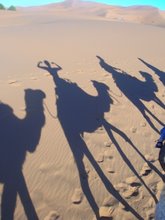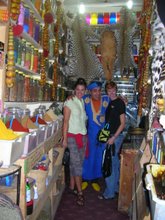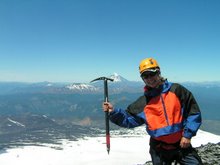An Odyssey of the Mine
A mine blowing experience, with mine over matter conditions; digging deep into the Bolivian mining industry.
Marily MacDonald
Down, down, down we went, the temperature and level of apprehension increasing every step of the way. We ventured into the dark, musty mine a bit dubious as of what we were getting ourselves into. This was the real deal, no safety ropes, railings or liability forms to be had. The mines in Potosi are far from being up to code, talk about venture at your own risk! Having to crawl through stifling passages and ducking makeshift support beams made descending the 275 feet no easy endeavor. I found myself thinking for the first time in a long while, ¨´what have I gotten myself into?¨´ We could hear random rumblings, drips and echos from the mysterious alley-ways that we passed. Air was pumped down through tubes but it still felt like your lungs were constricted. As we made our way deeper into the mine we encountered many of the workers placing dynamite for blasting or shoveling loads of rock into bags to be hauled out by hand. We were on edge as it was, let alone when a two ton cart full of ruble came zooming up behind us giving us little warning to get out of the way. (Which meant finding a wider spot in the path and gluing yourself to the side of the tunnel wall as three men pushed the immense load hurriedly by.) The abandoned 30 to 50 ft shafts were also a bit worrisome. Arsenic, espestice and silica dust get stirred into the air, adding to the many health risks of working in these mines. At least we had hard hats and masks on, unlike the miners. Three hours too much we spent nervously exploring these hellish conditions.
Bolivia is the poorest county in South America yet mineral rich. Zinc, Silver, Tin and Lead can all be found within the mountains surrounding the highest city in the world, Potosi (4090m =13,418ft). The life expectancy is around thirty years for the miners so many of the families are left fatherless. This results in the perpetuation of a vicious cycle, as young boys no older than ten begin their hard lives below ground. The workers pay many respects to the Devil and have even built shrines in some abandoned caverns. Coca is a vital vice (used like ch-aw in the cheek) accepted by the culture as a way to help workers remain awake throughout their shifts. At the moment mineral prices are up and a worker can make $300 US a month which is twice as much as the average Bolivian makes. 250 Co-ops work individually to extract as much mineral rich ruble as possible from the already exhausted mountain, 'cerro rico'. After processing and filtering (where hydrochloric acid and other dangerous chemicals are used generously) a sludge is left consisting of about 30% usable mineral content. Once dried and bagged (all by hand) the matter is shipped to Asia for processing, and the silver is used in microchips. Goodbye Cerro Rico hello Toshiba, IBM, Dell, and Hewlet Packard.
The whole experience was rather daunting. (to learn more check out the film The Devils Workers). Lifestyles vary greatly throughout the world but some situations are so harsh it makes one feel very grateful for what we have. The situation is extreme but the people are hard workers and know no other way. There is defiantly no whistling while you work in these mines.
Subscribe to:
Post Comments (Atom)






























No comments:
Post a Comment